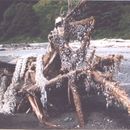Biology
provided by Arkive
Goose barnacles are marine crustaceans but, unlike many other members of their class, they are hermaphrodites, meaning that the animal has both male and female sexual organs. Their eggs hatch into free-swimming larvae, which drift with the ocean currents as one of the immense number of animals that comprise zooplankton.
As they develop, the larvae attach themselves to an object by way of a strong stalk or 'peduncle'. Once they have attached themselves to an object, they do not move again unless torn off by accident. As they grow they develop a feathery feeding apparatus, which filters particles of food from the water as the current passes over it. This filter can be speedily withdrawn inside the hard capitulum when the barnacle feels threatened.
If barnacles grow in sufficient numbers on the hull of a ship, they increase the vessel's drag though the water and have to be removed when the ship is dry-docked. However, they were considered a great delicacy in some parts of the world. Even in Cornwall, if a boat arrived with clusters of barnacles attached to the hull, they were scrapped off and sold for food.
Conservation
provided by Arkive
As this species is not listed as threatened, there are currently no conservation programmes for goose barnacles.
Description
provided by Arkive
Goose barnacles gave rise to one of the strangest of animal beliefs. The heart-shaped shell, or 'capitulum', is a chalky-white in colour and has black lines, which were thought to resemble the head of the barnacle goose Branta leucopsis. Because barnacle geese rarely nest in Britain no-one had ever seen their eggs or nests. It was supposed, therefore, that the geese 'grew up on the planks of ships' and the birds finally emerged clothed in feathers and flew away. This curious theory also provided a convenient way round the church's ban on eating meat or flesh on Fridays. As the barnacle goose was obviously “not born of the flesh” but from a barnacle, they could be eaten not just on Fridays but throughout Lent!
Habitat
provided by Arkive
This species is found attached to rocks, the planking of wooden ships, on driftwood, discarded rope; in fact, anything floating or fixed. A related species has also been found attached to the bodies of whales.
Range
provided by Arkive
Goose barnacles occur throughout most of the temperate seas of the world.
Status
provided by Arkive
Common
Threats
provided by Arkive
Goose barnacles are common around the British coast and, apart from the ever-present threat of marine pollution, are not presently endangered.

